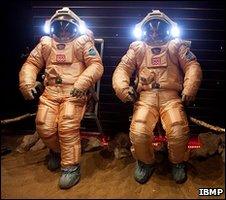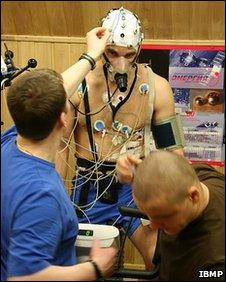Q&A: Simulated Mars mission
- Published
Six men have volunteered to be locked in a series of sealed containers in Moscow for 18 months in order to simulate a crewed mission to the Red Planet.
The experiment is designed to be as realistic as possible - though some elements, such as weightlessness - cannot be recreated on Earth.
What is the purpose of the study?
The Mars500 experiment is designed to help scientists understand how humans would cope on a long-haul space journey.

The experiment even simulates surface operations at the Red Planet
To this end, the six candidates - three Russians, two Europeans and one Chinese - will be sealed in a series of interconnected steel canisters for 520 days. The experiment is based in Russia, at Moscow's Institute of Biomedical Problems (IMBP).
The European Space Agency (Esa) says future astronauts need to be prepared mentally and physically for the demands of a long-duration space voyage.
Officials say a better understanding is needed of how crews will be affected by the boredom and isolation of a long space journey as well as by their interactions with other astronauts.
What will the "cosmonauts" do during the mission?
The "cosmonauts" will simulate all the steps of a real mission to the Red Planet: travelling to their target, orbiting Mars, landing on the surface and returning to Earth.
Once sealed into the chamber, the candidates will have only personal contact with each other plus voice contact with a simulated control centre as well as family and friends - just as would happen in a real mission.
The volunteers are required to be self-reliant, organising many of their own daily tasks. They are responsible for monitoring their own health and psychological states, as well as those of their colleagues.
They are also required to monitor and maintain life-support systems as well as controlling their consumption of limited resources.
During "surface operations" on Mars, the crew is divided up into two groups of three.
One group will go to a separate container where they will step through a hatch on to the Martian surface (actually a room with a floor covered with sand and rocks), while the other group remains in the main "spaceship".
The participants act as subjects in scientific investigations to assess the effect that isolation has on various aspects of their physiology and psychology.
These include stress, hormone regulation and immunity, sleep quality, mood and the effectiveness of dietary supplements.
How closely can they recreate a space mission on Earth?
Clearly, there are some aspects of a mission to deep space which cannot be recreated on our planet. These include the effects of weightlessness on astronauts.

Near a hundred experiments will be performed during the "journey"
But scientists have tried to make the experience as realistic as they possibly can.
For instance, they have built in a 20-minute delay into communications with their control centre - to mirror the real lag in sending messages over the vast distance between Mars and Earth.
In addition, all the consumables available for use by the crew are already on board - there will be no re-supply.
They will eat a diet that is very similar to that given to astronauts on the International Space Station. They will, however, have a greenhouse where the can grow some food.
Scientists will simulate different emergency scenarios such as illnesses among the crew and the failures of on-board systems.
The scientists will be watching the crew's psychological response during their confinement, in order to watch for conflicts.
How were the final six candidates chosen?
The volunteers comprise three Russian nationals - mission commander Alexey Sitev (38), Sukhrob Kamolov (32) and Alexander Smoleevskiy (33). Kamolov and Smoleevskiy both have medical backgrounds.
The two Europeans in the group - Colombian-Italian Diego Urbina (27) and Frenchman Romain Charles (31) - are engineers by training.
The Chinese citizen, Yue Wang, has a "day job" training Chinese astronauts.
There were two parallel tracks of candidate selection for the study, one organised by Europe, the other by Russia.
But all applicants for both selection tracks had to comply with certain requirements regarding their age, height, weight, education, skills and proficiency in English and Russian.
Shortlisted candidates were subjected to a battery of medical and psychological tests, as well as face-to-face interviews to determine their suitability for the experiment.
The selection panels not only considered the applicants' individual personalities but also how different personalities and talents would work when combined as a group.
Women were not excluded from the project. It was felt however that if females were to be included, at least two should go into the spaceship; but only one women made it through to the final interview stage.
- Published3 June 2010